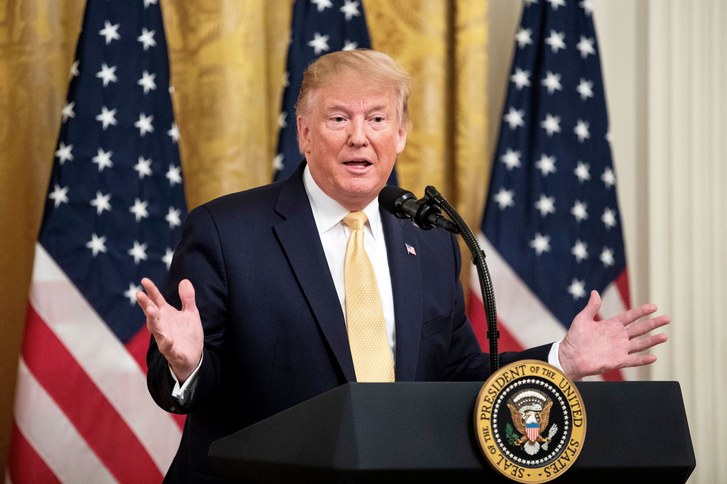
U.S. and China are close to finalising an agreement on the first phase of the ongoing trade deal
The President of United States (U.S.) – Donald Trump has said that U.S. and People’s Republic of China are close to finalising an agreement on the first phase of the ongoing trade deal.
The announcement came after top negotiators from both the sides spoke over telephone on Tuesday, i.e., November 26, 2019 and agreed to work in collaboration. Trump confirmed that Washington is in “final throes” of work on a deal that would put an end to the 16-month long trade war with Beijing.
The participants of the telephone call included U.S. Trade Representative – Robert Lighthizer, U.S. Secretary of Treasury – Steven Mnuchin, Vice Premier of China – Liu He, Commerce Minister of China – Zhong Shan, Governor of People’s Bank of China – Yi Gang and Director of the National Bureau of Statistics (NBS) of China and Vice Chairman of the National Development and Reform Commission – Ning Jizhe.
What China wants in Phase 1?
The Phase-1, which was expected to be complete by November 2019, may now get finalised by January 2020. This could be majorly due to discussions on China asking for more extensive tariff rollbacks. This includes 15% of tariff implemented on U.S. $ 125 billion worth of Chinese goods on September 1, 2019 and a rollback of 25% of tariff imposed on industrial and consumer imports to the U.S. from China.
However, it is to be noted that if the first phase is not finalised by December 15, 2019, then Trump will have to decide, as announced earlier, that whether he wants to impose further 15% tariffs on a separate set of U.S. $ 160 billion imports from China.
What Trump said?
Addressing the reporters at White House, Trump also mentioned about U.S.’s support to protestors in Hong Kong. For the records, Hong Kong is experiencing mass unrest for the past 6 months over the now abandoned Extradition Bill. The Extradition Bill, if implemented, would have allowed China, Taiwan and Macau to place extradition request for suspects accused of criminal wrongdoings. The requests would have then been decided on a case-by-case basis. However, owing to mass unrest, The Chief Executive – Carrie Lam later announced that the Government has suspended the controversial Extradition Bill.
Speaking on the occasion, Trump said, “We’re in the final throes of a very important deal, I guess you could say one of the most important deals in trade ever. It’s going very well but at the same time we want to see it go well in Hong Kong,” Trump told reporters at the White House.”
Trump also mentioned that he shares a very good relationship with the President of China – Xi Jinping and hopes Xi will ensure a win-win situation for all in the ongoing crisis in Hong Kong.
Trump further added, “I think that President Xi can make that happen. I know him and I know he’d like to make it happen.”
Later in the day, Trump also gave an interview to U.S. based news channel – Fox News. “I’m holding it up because it’s got to be a good deal. We can’t make a deal that’s like, even. We have to make a deal where we do much better because we have to catch up,” said Trump to Fox News.
What next?
To take the negotiations forward, U.S. representatives may visit China on Thursday, i.e., November 28, 2019, after the Thanksgiving Holiday.
It is to be noted that U.S. would be holding Presidential elections in 2020 and in the wake of the polls, the deals becomes significantly important as Trump is keen of highlighting the achievements of his Government.
The growing concerns of Chinese economy
According to the data released by NBS, today, i.e., November 27, 2019, China’s economy grew by 6.0% in the 3rd quarter of 2019, the lowest growth rate since growth recording was started in March 1992. The profits at China’s industrial firms fell 9.9% in October 2019 as compared to 2018 for the same period, marking the steepest fall since 2011.
October’s fall in profits to 427.56 billion Yuan (U.S. $ 60.7 billion) was worse than a 5.3% contraction in September 2019. The contraction was the third straight month of decline. In the first 10 months of the year, combined profits at Chinese industrial enterprises decreased 2.9% Year-On-Year.
Profits in the manufacturing sector fell 4.9% between January 2019 and October 2019. Coal mining and the oil and gas sector recorded declines of 2.9 % and 2.1%, respectively. On the contrary, there was slight respite with mining sector witnessing 2.4% increase in profit and utilities sector experiencing an increment of 14.4% in profits.
The country’s official manufacturing purchasing managers’ index also declined for the 6th straight month in September 2019 as new export orders fell for the 17th month in a row. However, the analysts are hopeful that if the trade war with U.S. comes to an end, the Chinese economy could register a growth of 6% in 2020 and may exceed it.







